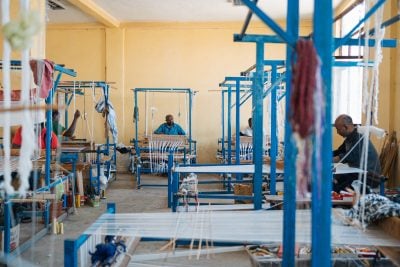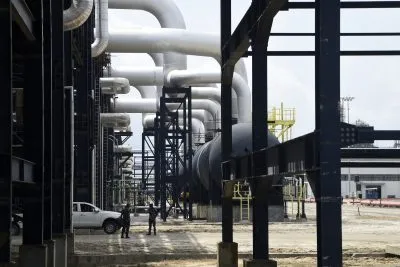This article explores seven questions relating to the African Continental Free Trade Area (AfCFTA):
- What is the AfCTA?
- Have negotiations on the AfCFTA been completed?
- Why does Africa need the AfCFTA?
- What are the predicted economic benefits of the AfCFTA?
- How will the AfCFTA work with existing regional trade areas in Africa?
- What does the AfCFTA say about the free movement of people?
- Can the AfCFTA succeed?
What is the AfCFTA?
The AfCFTA is an ambitious trade pact to form the world’s largest free trade area by creating a single market for goods and services of almost 1.3bn people across Africa and deepening the economic integration of Africa. The trade area could have a combined gross domestic product of around $3.4 trillion, but achieving its full potential depends on significant policy reforms and trade facilitation measures across African signatory nations.
The AfCFTA aims to reduce tariffs among members and covers policy areas such as trade facilitation and services, as well as regulatory measures such as sanitary standards and technical barriers to trade.
The agreement was brokered by the African Union (AU) and was signed by 44 of its 55 member states in Kigali, Rwanda on March 21, 2018. The only country still not to sign the agreement is Eritrea, which has a largely closed economy.
As of May 2022, 46 of the 54 signatories had deposited their instruments of ratification with the chair of the African Union Commission, making them state parties to the agreement.
The AfCFTA Secretariat, an autonomous body within the African Union based in Accra, Ghana, and led by secretary general Wamkele Mene, is responsible for coordinating the implementation of the agreement.

Have negotiations on the AfCFTA been completed?
Trading under the agreement commenced on 1 January 2021, after a sixth month delay as a result of the impact of Covid-19. However, negotiations on many issues need to be resolved before the agreement can fully function. The negotiations have been divided into three phases:
- Phase 1 negotiations – trade in goods and services. Negotiations led to the ratification of legal instruments (the AfCFTA agreement itself and protocols on trade in service and goods and settlement of disputes) that came into force on 30 May 2019, permitting the launch of trading. However, negotiations continue on many details (see below).
- Phase 2 negotiations – intellectual property rights, investment and competition policy. Some of these negotiations have already begun.
- Phase 3 negotiations – e-commerce. These negotiations are due to begin when phase 2 is complete.
Negotiations are under way to eliminate tariffs on 90% of goods over a five-year period (10 years for least developed countries, or LDCs). An additional 7% of tariff lines are deemed “sensitive”. Tariffs on these goods will be eliminated over a 10-year period (13 years for LDCs). A remaining 3% of tariff lines can be excluded from liberalisation, but the value of these goods cannot exceed 10% of total intra-African imports.
Negotiations on rules of origin have proved a sticking point: “While some countries are arguing for stringent rules of origin to ensure that preference accrues only to members and is not deflected to non-members, others – generally the least developed countries with weaker productive capacities – advocate more flexible, pro-developmental rules that allow them to source inputs from the cheapest and most competitive locations,” explains Hippolyte Fofack in an article for the Journal of African Trade.
As of 13 March 2023, negotiations on rules of origin were 88.3% complete, with completion and implementation “expected soon”, according the the African Policy Research Institute (APRI).
As APRI notes, the countries considered to be taking harder lines in the negotiations are Mauritius, Nigeria and South Africa. While Nigeria takes a “conservative line” on openness to trade in an attempt to protect industries that are “non-existent or unformed”, more-industrialised South Africa wants to protect the large share it already has of intra-African trade while Mauritius is seeking more liberal rules of origin for textiles and apparel, a sector in which it could profit from its free trade agreement with China.
Guided Trade Initiative allows a degree of meaningful trading
Given the slow progress of negotiations, in October 2022, the Guided Trade Initiative was launched to allow a degree of free trade between countries that have met minimum requirements for trade under the AfCFTA. Eight countries (Cameroon, Egypt, Ghana, Kenya, Mauritius, Rwanda, Tanzania and Tunisia) are taking part, representing the different regions of Africa. According to the Secretariat, its aims are to:
- enable a degree of meaningful trade to commence between the participating countries
- test the operational, institutional, legal and trade policy environment under the AfCFTA
- send an important positive message to the African economic operators.
In September, as a prelude to the launch, Kenya and Rwanda exported their first goods to Ghana under the AfCFTA, with the former exporting Exide batteries and the latter premium coffee.
The Secretariat says it hopes that the Initiative “will serve as a gateway to encourage continued trade under the AfCFTA, resulting in a multiplier effect and increased opportunities for SMEs, Youth and Women in trade and ultimately establishing sustainable and inclusive economic development”.
Other advances in implementation of the AfCFTA
On 10 March 2023, the AfCFTA Secretariat and Afreximbank announced the launch of the AfCFTA Adjustment Fund. The Adjustment Fund consists of a Base Fund, a General Fund, and a Credit Fund, which will work together to support African countries and the private sector as they adjust to the new trading conditions. According to Afreximbank, the $10bn fund will help to mitigate potential adverse effects of the tariff losses many countries will suffer and to address infrastructure deficits and supply chain bottlenecks that impede implementation of the AfCFTA.
The Pan-African Payment and Settlements System was launched by Afreximbank in September 2021 with the support of the AfCFTA Secretariat. It is a continent-wide platform for processing, clearing and settling intra-African payments, designed to enable individuals, businesses and governments to make instant cross-border payments in the more than 40 different African currencies, thereby reducing the need for US dollars and other hard currencies and so, simplifying cross-border trade. Its launch and operation create important advantages for the African banking sector.
Afreximbank is currently assisting the African Regional Standards Organisation to harmonise 155 standards in three priority areas – automotives, pharmaceuticals and medical equipment – with work also under way with regard to textiles. These sectors are seen as key to boosting manufacturing in Africa, thereby reducing imports from the rest of the world.
Read more about the AfCFTA
- Africa Day 2023: Accelerating implementation of the AfCFTA
- AfCFTA: We need business support to succeed
- Does the US support the AfCFTA?
Why does Africa need the AfCFTA?
Trade integration across the African continent has long been limited by outdated border and transport infrastructure and a patchwork of differing regulations across dozens of markets.
Governments have often erected trade barriers to defend their markets from regional competition, making it more expensive for countries to trade with near neighbours than countries much further afield.
Intra-African exports were 16.6% of total exports in 2017, compared with 68.1% in Europe, 59.4% in Asia, 55% in America and 7% in Oceania, according to UNCTAD. Intra-African trade, defined as the average of intra-African exports and imports, was around 2% during the period 2015–17.
The share of exports from Africa to the rest of the world ranged from 80% to 90% in 2000-17 – only Oceania had a higher export dependence on the rest of the world in that period.
What are the predicted economic benefits of the AfCFTA?
In a 2020 report, the World Bank estimated that by 2035, real income gains from full implementation of the agreement could be 7%, or nearly $450bn. By 2035, the volume of total exports would increase by almost 29% relative to business as usual. Intra-continental exports would increase by more than 81%, while exports to non-African countries would rise by 19%.
The Bank predicts that the agreement could contribute to lifting an additional 30m people from extreme poverty and 68m people from moderate poverty.
Yet the impact across countries will not be uniform. The World Bank says that at the very high end, countries like Côte d’Ivoire and Zimbabwe could see income gains of 14% each. At the low end, some – such as Madagascar, Malawi, and Mozambique – would see real income gains of only around 2%.
In a follow-up report published in June 2022, the Bank listed benefits from the expected increase of foreign direct investment (FDI) expected to accrue from the agreement.
Under an “AfCFTA FDI broad scenario” it predicts that Africa may record an increase of 111% in FDI, further boosting real income gains in Africa to about 8% in 2035.
Under an “AfCFTA FDI deep scenario” it examines the additional gains that could result from expanding the agreement from trade in goods and services to harmonising policies on investment, competition, e-commerce, and intellectual property rights.
Under this scenario it predicts an increase in FDI of 159% and that income gains could increase by up to 9% by 2035.
Other potential benefits of the AfCFTA highlighted by the June 2022 report include:
- Higher-paid, better-quality jobs, with women seeing the biggest wage gains.
- Wages rises of 11.2% for women and 9.8% for men by 2035, albeit with regional variations depending on the industries that expand the most in specific countries.
- Under deep integration, a rise in Africa’s exports to the rest of the world of 32% by 2035, while intra-African exports would grow by 109%, led by manufactured goods.
In its Economic Development in Africa Report 2021, the UN Conference on Trade and Development (UNCTAD) said that “the total untapped export potential of intra-African trade is around $21.9 billion, equivalent to 43 per cent of intra-African exports”.
“More than one third of that export potential is explained by frictions, namely, static untapped export potential, which implies that $8.6 billion in trade could be realized by engaging actively in efforts to identify and address current market frictions in African trade today,” said the report.
How will the AfCFTA work with existing regional trade areas in Africa?
The majority of existing intra-African trade is carried out within the continent’s regional economic communities, which include the Common Market for East and South Africa (COMESA), the East African Community (EAC), the Economic Community of West African States (ECOWAS) and the South African Development Community (SADC), among others.
According to the African Union, the RECs have developed individually and each has its own distinct arrangements, but their common purpose is to facilitate regional economic integration, and they are “increasingly involved in coordinating AU Member States’ interests in wider areas such as peace and security, development and governance”.
The AfCFTA Agreement recognises the RECs as the “building blocks for the AfCFTA”. As APRI notes, the Agreement envisages that countries which have already attained higher elimination of trading or customs barriers as members of RECs “shall maintain such higher levels among themselves”, while the Protocol on Trade in Goods says that “State Parties that are members of other RECs, which have attained among themselves higher levels of elimination of customs duties and trade barriers than those provided for in this Protocol, shall maintain, and where possible improve upon, those higher levels of trade liberalisation among themselves.”
According to an analysis by the World Bank, in the policy areas already covered by the RECs, the AfCFTA will offer a common regulatory framework, reducing market fragmentation created by different sets of rules.
Secondly, the AfCFTA will be an opportunity to regulate policy areas important for economic integration that are often regulated in trade agreements but that so far have not been covered in most of Africa’s RECs, which the Bank says “tend to be shallow”.
What does the AfCFTA say about the free movement of people?
Policymakers say that the free movement of labour will be a key contributor to the successful functioning of the free trade area, but not all African countries are committed to the concept.
Alongside the signing of the AfCFTA agreement and the supporting Kigali Declaration, 30 African nations signed the Protocol on Free Movement of Persons which seeks to establish a visa-free zone within the AfCFTA countries. However, major AfCFTA signatories Nigeria and South Africa have not signed the Protocol and the political will to do so is lacking.
Can the AfCFTA succeed?
In an interview with French daily Le Monde in January 2022, African economist Carlos Lopes underlined the potential that the AfCFTA gives Africa to speak with one voice in trade negotiations.
Europe has 13 types of trade arrangements with Africa, each of which it defends firmly, he told the newspaper.
“Europe needs to understand the direction Africa is going in with the setting up of the AfCFTA… We Africans must be more united to defend our own interests,” he declared.
His comments echo those of Gyude Moore, senior policy fellow at the Center for Global Development, in the December 2020 issue of African Business:
“This is an African project that will require African commitment to succeed. It must proceed regardless of what happens elsewhere. We can expect external actors to continue to pursue policies that run counter to Africa’s objectives as long as such policies benefit them. Even as we have made clear our intent to move trade along a multilateral track, Africa’s largest partners may seek to pursue a bilateral one.
“Despite the rhetoric of Africa’s external partners, the continent’s prosperity has never been the true objective of their policies and we cannot expect that to change now.”
Towards a Made in Africa revolution – boosting Africa’s regional value chains
“The AfCFTA is much more than a trade agreement. It should be seen as an instrument for Africa’s development. By driving the continent’s integration, the AfCFTA will result in wider and deeper RVCs [regional value chains], thereby laying foundations for a Made in Africa Revolution,” write the authors of the AfCFTA’s 2021 Futures Report.
As African economies seek to move away from being suppliers of raw materials to the rest of the world and towards trading more value-added products with each other, developing RVCs will enable countries to combine their comparative and competitive advantages to participate in industries from which they would otherwise be excluded.
“The ability for the AfCFTA to drive this transformation in Africa is partly dependent on the successful transition from current inward-looking approaches to trade and investment towards the strengthening of RVCs where different segments of the industry VCs are located across the region reflecting local comparative advantage,” say the authors.
Applying a methodological assessment of the tariff and services offers that have been exchanged amongst AfCFTA state parties, the report identifies 10 value chains where new opportunities can be maximised: Automotives; Leather and Leather Products, Cocoa; Soya; Textiles and Apparel; Pharmaceuticals; Vaccine Manufacturing; Lithium-Ion Batteries; Mobile Financial Services; and Cultural and Creative Industries.
The report aims to help governments target sectors that can benefit from their country’s entry into the AfCFTA and market players to better understand where they should invest. It also offers views from industry players running exporting enterprises in some of the value chains identified, all in the service of creating a Made in Africa revolution.
Additional research by Charles Dietz.
Want to continue reading? Subscribe today.
You've read all your free articles for this month! Subscribe now to enjoy full access to our content.
Digital Monthly
£8.00 / month
Receive full unlimited access to our articles, opinions, podcasts and more.
Digital Yearly
£70.00 / year
Our best value offer - save £26 and gain access to all of our digital content for an entire year!
 Sign in with Google
Sign in with Google 



